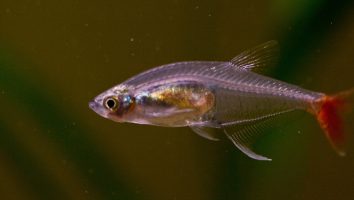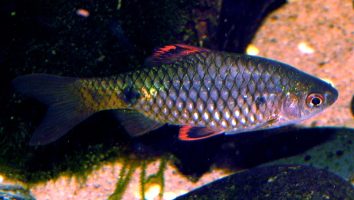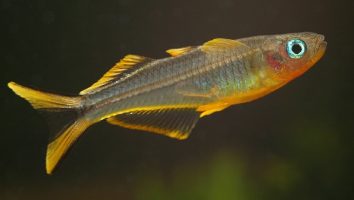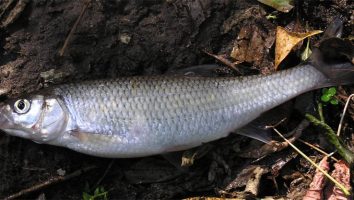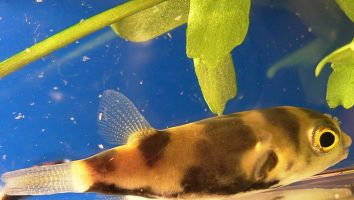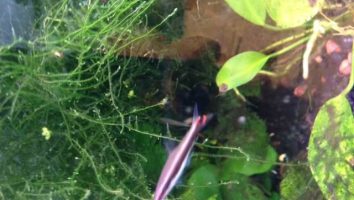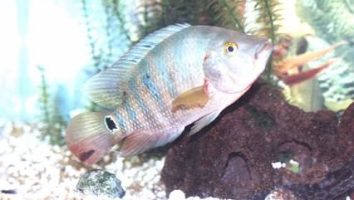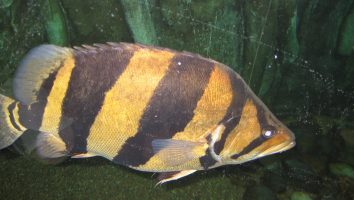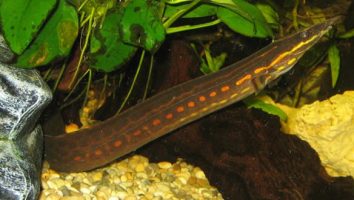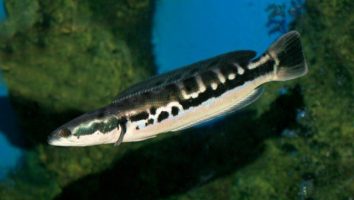Peacock bass are an amazing freshwater fish that are perfect for the intermediate aquarist.
They’re relatively easy to care for, but do require a little more attention than some of the other beginner-friendly options out there.
But they’re more than worth the effort, as they’re absolutely stunning fish that are a lot of fun to watch.
If you’re thinking about getting a peacock bass, this guide will teach you everything you need to know about their care. Diet, tank size, lifespan, and more!
Table of contents
Species overview
The peacock bass (scientific name: Cichla temensis) is a freshwater fish that’s native to the Amazon Basin in South America.
They are a predatory fish that primarily feeds on other fish, although they will also eat insects, crustaceans, and other small aquatic creatures.
Peacock bass are a popular choice for aquariums and fish tanks because of their bright colors and patterns. They are also a relatively hardy fish, which means they can withstand a wide range of water conditions.
However, it’s important to note that peacock bass can grow to be quite large. They can reach lengths of up to three feet, so it’s important to make sure you have a sufficiently large tank before you decide to add one of these fish to your collection.
Appearance
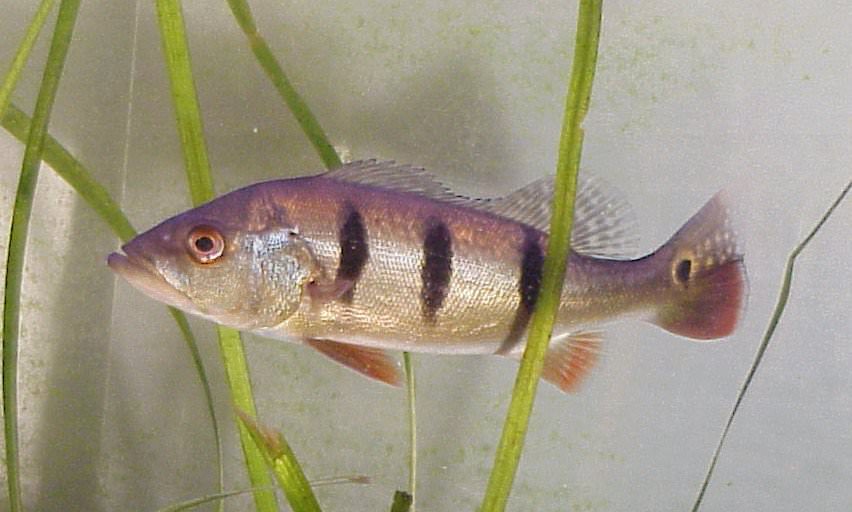
The first thing you’ll notice about this beautiful freshwater fish is their coloration. Peacock bass have a dark green body with light blue spots all over. The spots are relatively large, but they’re not so big that they obscure the green coloration.
The fins on this species are all fairly large and help the fish move through the water with ease. The dorsal and anal fins are both long and extend back quite a bit.
The caudal fin is forked and symmetrical. The pectoral fins are also large and help the fish make tight turns.
The face of the peacock bass is fairly flat with large eyes that sit high on their head. They have a large mouth that is lined with sharp teeth.
The body of the peacock bass is long and thin. This helps them swim quickly and easily through the water.
Lifespan
In the wild, peacock bass typically only live for about 5 years. This is due to a number of factors such as disease, predators, and competition for food.
In captivity, however, peacock bass can live much longer – up to 20 years in some cases! This is due to the fact that they are protected from many of the dangers they face in the wild.
Size
The average size of a peacock bass is between 20 and 30 inches, but they can grow up to 40 inches in length. Males are typically larger than females, and they can weigh up to 15 pounds.
Tank
Tank Size
The minimum tank size for a single peacock bass is 100 gallons but we recommend going up to at least 125 gallons if you have the space. If you want to keep more than one peacock bass in your tank, you’ll need to increase the size by at least 50 gallons for each additional fish.
As you can see, peacock bass are not fish for beginners. They require a significant investment in terms of time, money, and space.
Water Parameters
The ideal water parameters for keeping peacock bass are quite specific. To maintain a healthy environment, you must stick to the following range.
- Water Temperature: 75 to 82 degrees Fahrenheit
- pH Levels: 6.5 to 7.5
- Water Hardness: 5 to 15 dGH
- Alkalinity Levels: 4-8 dKH
What To Put In Their Tank
Peacock bass are one of the most popular freshwater aquarium fish for a reason: they’re absolutely beautiful.
Their vibrant colors and patterns are enough to make any fish tank stand out. But if you really want your peacock bass to shine, then you need to create the right environment for them.
The first thing you need to do is choose the right size tank. These fish can grow to be quite large (up to 2 feet in length in some cases) so you need to make sure you have enough room. A good rule of thumb is to get a tank that’s at least 50 gallons for one fish.
Next, you need to choose the right substrate. Peacock bass are bottom-dwellers so they’ll be spending a lot of time on the floor of the tank. A soft, sandy substrate is ideal since it’s easier on their bellies.
When it comes to plants, you have a few options. Peacock bass are known to nibble on vegetation, so you’ll need to choose something that can withstand a little abuse. Hornwort, Water Wisteria, and Java Moss are all great choices.
You should also include some driftwood or rocks in their tank. These provide hiding places for your fish and help create a more natural environment.
Last but not least, make sure you have a good filtration system. Peacock bass are messy eaters and produce a lot of waste, so you need a filter that can keep up with them.
Common Diseases
Peacock bass are a hardy and disease-resistant fish, but that doesn’t mean they can’t get sick. There are a few diseases that these fish are susceptible to, and it’s important to be aware of them.
The most common disease that affects peacock bass is ich. This is a parasitic infection that will present itself as white spots on the body of your fish.
If left untreated, ich can be fatal. However, it’s relatively easy to treat if you catch it early.
The other disease that you need to be aware of is columnaris. This is a bacterial infection that can affect the skin, gills, and fins of your fish.
It’s most commonly caused by poor water conditions, so the best way to prevent it is by maintaining a clean and stable tank.
If you notice any of these diseases in your peacock bass, it’s important to act fast. Begin treatment immediately and consult your vet if necessary.
Behavior & Temperament
The peacock bass is a predatory fish with a reputation for being aggressive. In the wild, these fish are known for attacking other fish, birds, and even small mammals!
While their aggression level is certainly something to be aware of, it’s important to remember that they are only aggressive when they feel threatened. In most cases, they will leave other fish alone.
The peacock bass is a shy fish by nature, so it’s not uncommon for them to hide when they first enter a new environment. They’ll eventually come out when they feel more comfortable, but it may take some time for them to adjust.
Once they’ve settled in, they’ll be more active and you’ll see them swimming around more often. They’re curious fish, so they’ll often explore their surroundings.
When it comes to feeding time, the peacock bass can be a bit aggressive. They’re known for stealing food from other fish, so it’s important to keep an eye on them during mealtimes.
Tank Mates
Peacock bass are known for being aggressive. They’re not the type of fish that you can just put in with any other species and hope for the best.
You need to be strategic when choosing peacock bass tank mates. The goal is to find fish that can hold their own against this bass’s aggression.
At the same time, you don’t want to put in fish that are so large that they’ll make a meal out of your peacock bass.
It’s a tricky balance, but there are definitely some species that can work.
Some good tank mates for peacock bass include:
- Oscar Fish
- Green Terror
- Jack Dempsey
- Firemouth Cichlid
- Convict Cichlid
- Chocolate Cichlid
- Blood Parrot Cichlid
Breeding
The best time to breed peacock bass is during the rainy season. This is when the fish are naturally inclined to mate.
To breed peacock bass, you need to set up a special breeding tank. The tank should be at least 200 gallons and should have a water temperature of around 82 degrees Fahrenheit. The pH should be between 6.5 and 7.5.
You also need to add a lot of hiding places. These fish like to spawn in caves, so add plenty of rocks and driftwood for them to choose from.
When the tank is set up, add two males and two females. The males will start to chase the females around until they’re ready to mate.
Once the female is ready, she’ll lay her eggs in a hidden area. The male will then fertilize them. After that, the female will leave and the male will stay to guard the eggs.
It takes about two weeks for the eggs to hatch. When they do, the fry will be very small. They’ll need to be fed live food until they’re big enough to eat brine shrimp and other dry foods.
Conclusion
Peacock bass are beautiful, unique fish that make a great addition to any freshwater aquarium. They’re not the easiest fish to care for, but with a little bit of knowledge and commitment, you can successfully keep them healthy and happy.
If you’re looking for a fish that will stand out in your tank and provide you with hours of enjoyment, the Peacock Bass is a great choice!

